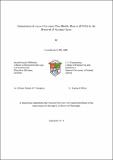| dc.description.abstract | Significant health and environmental concerns can arise from emissions of greenhouse and noxious and odorous gases that are generated in wastewater treatment plants (WWTPs), landfills, and agricultural processing and composting facilities. Noxious and odorous gases generally have no residual value and in the case of methane (CH4, a greenhouse gas), emissions are often high volume and low concentration, and thus also have no residual value (e.g. the concentrations of methane contained in emissions from landfills are often too low to be suitable for energy recovery). Increasingly stringent legislation in Ireland and the European Union (EU) means that the development of innovative and sustainable solutions for remediating such emissions is necessary.
Methods of remediating nuisance gas emissions from the waste and wastewater sectors include physical, chemical and biological techniques. Physical and chemical techniques include scrubbing, catalytic oxidation and non-thermal plasma oxidation. These methods can provide effective treatment, but are limited insofar as they often require high capital investment, generate secondary pollutants and can have high maintenance costs.
In recent years biological treatment, in particular biofiltration, has become established as an effective alternative, with advantages including low capital and maintenance costs, energy efficiency, no requirement for chemicals and good long-term performance. Traditional biofilter design can, however, also be subject to various constraints such as a necessity for occasional media replacement, clogging due to accumulation of biomass and metabolites, limited interphase mass transfer and excessive acidification of the packing material. The development of a biological technique which circumvents these issues is therefore timely.
In this laboratory study, a novel Horizontal Flow Biofilm Reactor (HFBR) technology, developed at NUI Galway, was tested for its efficacy in treating some of these gases, namely CH4, hydrogen sulphide (H2S) and ammonia (NH3). The HFBR units were simultaneously dosed with contaminated air and a liquid nutrient feed (LNF). The contaminated air and liquid flowed concurrently downward through each reactor in a boustrophedon fashion (i.e. moving over alternate surfaces or sheets in opposite directions). The boustrophedonic flow regime utilised by the HFBR technology was designed to increase contact between dissolved contaminant gas and biofilm on the sheets and reduce pressure drop. The reactors were all operated at 10oC, to replicate ambient air and wastewater temperatures most common in northern Europe.
During each trial, the influent and effluent gas concentrations were measured to establish removal efficiencies. Intermediate samples were also taken at sample ports located at discrete points down through the reactor. This allowed the establishment of removal profiles and gave a deeper insight into the removal mechanisms that developed in each of the reactors.
Analysis of the LNF as it flowed through the reactor was also carried out to allow a better understanding of microbial dynamics in the reactors.
The study provides crucial information on the critical relationships governing gas and liquid phase contaminant removals in biological treatment systems such as the HFBR. Various methods of improving reactor performance are investigated and a number of key recommendations concerning design and operational parameters are presented (for example, optimising liquid nutrient feed compositions to maximise performance, the critical parameters for indicating biofilm health and activity, possible methods of improving the reactor design, etc.).
The results of this study indicate that HFBR systems can provide a simple, low-maintenance, cost-effective and robust alternative to help minimise odour and greenhouse gas emissions from sectors such as waste and agriculture. | en_US |


